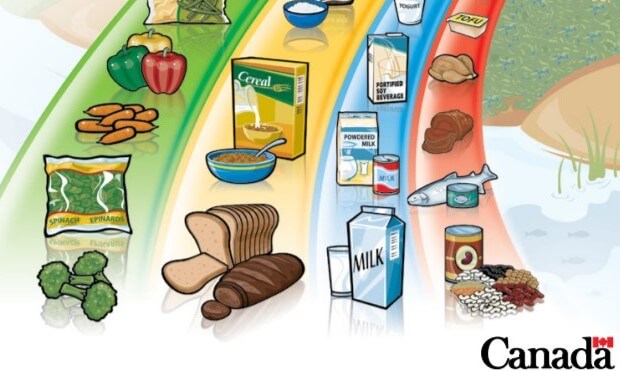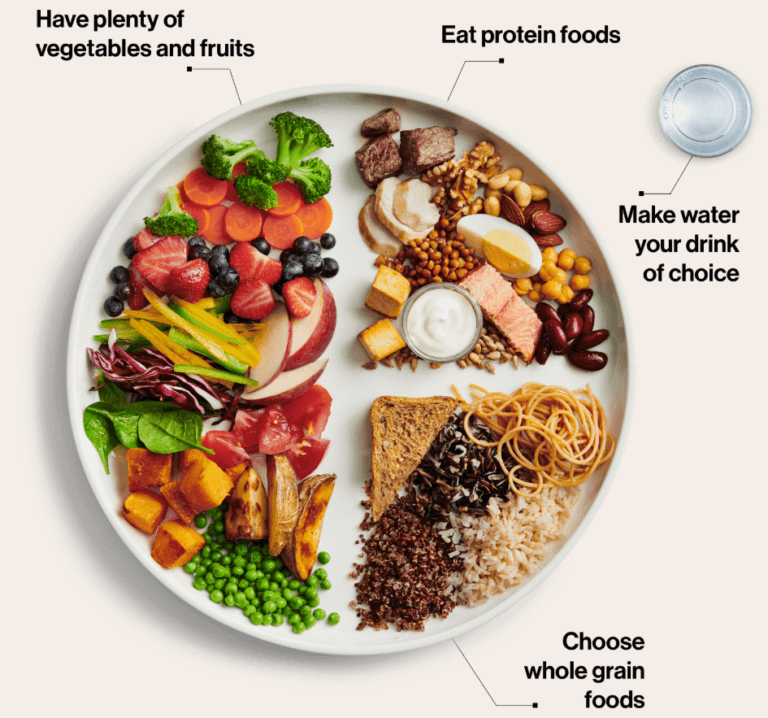Canada’s Food Guide just got a makeover! On January 22nd, 2019, Canada’s Minister of Health presented an update to the 2007 Canadian Food Guide. The new Food Guide comes complete with a fresh look, new measurements and major adjustments to previous guidelines.
What does it mean for your active kids? Let’s take a look!
Food Guide Serving Sizes & Numbers Are Out
For almost 40 years, Canada’s Food Guides used tables or rainbows to show four major food groups and their recommended servings (as shown below). Serving sizes varied on these guides, and the amount of servings also differed from food group to food group, making the measurements hard to understand.
Previous Food Guide

The new Food Guide, shown below, is much easier to understand. It tosses out difficult-to-grasp servings and serving sizes and replaces them with a plate.
Instead of trying to guess what 75 grams of fish looks like, now you can just look at your plate.
Does the piece of fish on your plate take up more than one quarter of your plate portion? If the answer is yes, then that’s more protein than the new Food Guide recommends for a meal. Simple!
New Food Guide

But there’s more than just a stylish new design to be found with today’s Canada’s Food Guide.
Load Up on Fruits and Vegetables
The Canada Food Guide has always recommended a large serving of fruits and vegetables. In the 2007 guide, it was the food group with the largest recommended serving size across every age group. However, it was only the largest by a small margin.
The previous food guide also recommended eating nearly as many servings of Grain Products as fruits and vegetables. If you combined the other two food groups, Milk and alternatives and Meat and alternatives, these were nearly as highly recommended as Grains.
As a result, the three new major food groups: Fruits and Vegetables, Proteins, and Whole Grains were almost equally represented in servings back in 2007. But, not anymore.
Canada’s Food Guide now recommends filling half of your plate with fruits and vegetables! They also explicitly recommend that when it comes to protein, “consume plant-based more often.” This move toward a plant-centered diet seems to align with most of the recent health trends and studies, so it’s not a complete surprise.
Takeaway: In addition to adding more fruits and veggies to your diet, it’s time to try some recipes with tofu, lentils, beans, or quinoa!
Say No to Sugary Drinks, Yes to Water
The World Health Organization recommends that sugary drinks should make up no more than 10% of daily energy intake. They further state that if you’re able to limit sugary drink intake to 5% of your daily energy, you will see additional health benefits.
As of 2015, Stats Canada reported that 25% of a child’s daily energy came from total sugars, and approximately 1/3 of those sugars (or 8.3%) came from beverages.
This suggests that children in Canada appear to be on the right track, so long as sugary drinks like sodas, flavoured milk and sports drinks continue to be limited in their diet.
Canada’s new food guide addresses this issue by only showing one beverage, water – and they don’t mince words about it! The new guide encourages everyone to, “make water your drink of choice.“
Many believe this will not only encourage hydration, but also discourage the consumption of sugary drinks which can lead to health issues for our kids, like diabetes and obesity.
Make Time to Eat A Meal Together
Eating Habits also get a good deal of attention in the new Canada Food Guide. Among them are reminders to “Cook More Often,” “Enjoy Your Food,” and “Eat With Others.”
At first glance, these seem like simple ideas, but often the simplest habits can have a big impact!
All of these habits encourage us to slow down.
For those with active kids playing sports, it can be easy to forget the value of slowing down and sharing a meal together. When we share a meal as a family, and take time to enjoy our food, we’re teaching our kids a couple of important things.
Firstly, when we enjoy our food, we teach the value of eating healthy, fresh meals.
When children see and experience the benefit of eating fresh meals, they can become more interested in their food. This can even spark an interest in helping out in the kitchen. And when kids learn to help in the kitchen, they develop cooking skills that can keep them eating healthier in College!
Secondly, when we share a meal as a family, we create an opportunity to socialize with our kids.
When everyone is seated at the table and the electronics are off, it’s easier to strike up a conversation.
These daily or weekly meals can help strengthen your child’s connection with their family which can be beneficial to their mental health. This also creates a great opportunity for parents to engage in conversations about mental health, like discussing bullying in sports or at school.
Be Aware of Food Marketing
One topic your family should also be interested in discussing at the dinner table is food marketing. We’re very happy to see that the new Canada Food Guide includes a section dedicated to making your family aware of food marketing.
Canada’s Food Guide explains numerous uses and effects of food marketing. Two that jump off the page include how food marketing can be used to “create trends,” and “links between certain foods or brands and a particular lifestyle.”
Both of these marketing tactics can lead to poor food choices. And both address the issue of companies making certain foods look “cool.”
Now, nothing is going to make a parent sound older than protesting “coolness”, but when it comes to food, it can make a lot of sense.
Food companies put a ton of effort into making their product look cool and appealing to consumers. It doesn’t matter whether it’s through multi-million dollar advertisements on TV, or a clever social media ad. It’s important for kids to understand that a food’s “coolness” is not a reflection of it’s nutritional value.
Furthermore, just because an elite athlete endorses a product, doesn’t mean it’s healthy for you! And it definitely doesn’t mean that you need to buy that product to perform like the pros!
A Holistic Health Approach for Kids
To sum it up, the new Food Guide brings a comprehensive approach to health. It not only addresses what we eat but also how we eat, who we eat with, and how to interpret food advertisements.
This means that incorporating recommendations from the new Food Guide can help your kids better understand healthy eating on multiple levels. The best part? Teaching kids about healthy foods today can have a compounding positive effect on their health in the future!
Healthy Snack Ideas
Eating healthy meals is important for the proper development of our kids. But it’s also important not to gloss over healthy snacking. When your family is in a rush, it’s easy to make poor food choices. However, a little prep work and some reusable containers can help your busy kids eat healthy. For some helpful suggestions, see our 7 Healthy Snack Ideas for Active Kids.
For almost 40 years, Canada’s Food Guides used tables or rainbows to show four major food groups and their recommended servings (as shown below). Serving sizes varied on these guides, and the amount of servings also differed from food group to food group, making the measurements hard to understand.
Previous Food Guide

The new Food Guide, shown below, is much easier to understand. It tosses out difficult-to-grasp servings and serving sizes and replaces them with a plate.
Instead of trying to guess what 75 grams of fish looks like, now you can just look at your plate.
Does the piece of fish on your plate take up more than one quarter of your plate portion? If the answer is yes, then that’s more protein than the new Food Guide recommends for a meal. Simple!
New Food Guide

But there’s more than just a stylish new design to be found with today’s Canada’s Food Guide.
Load Up on Fruits and Vegetables
The Canada Food Guide has always recommended a large serving of fruits and vegetables. In the 2007 guide, it was the food group with the largest recommended serving size across every age group. However, it was only the largest by a small margin.
The previous food guide also recommended eating nearly as many servings of Grain Products as fruits and vegetables. If you combined the other two food groups, Milk and alternatives and Meat and alternatives, these were nearly as highly recommended as Grains.
As a result, the three new major food groups: Fruits and Vegetables, Proteins, and Whole Grains were almost equally represented in servings back in 2007. But, not anymore.
Canada’s Food Guide now recommends filling half of your plate with fruits and vegetables! They also explicitly recommend that when it comes to protein, “consume plant-based more often.” This move toward a plant-centered diet seems to align with most of the recent health trends and studies, so it’s not a complete surprise.
Takeaway: In addition to adding more fruits and veggies to your diet, it’s time to try some recipes with tofu, lentils, beans, or quinoa!
Say No to Sugary Drinks, Yes to Water
The World Health Organization recommends that sugary drinks should make up no more than 10% of daily energy intake. They further state that if you’re able to limit sugary drink intake to 5% of your daily energy, you will see additional health benefits.
As of 2015, Stats Canada reported that 25% of a child’s daily energy came from total sugars, and approximately 1/3 of those sugars (or 8.3%) came from beverages.
This suggests that children in Canada appear to be on the right track, so long as sugary drinks like sodas, flavoured milk and sports drinks continue to be limited in their diet.
Canada’s new food guide addresses this issue by only showing one beverage, water – and they don’t mince words about it! The new guide encourages everyone to, “make water your drink of choice.“
Many believe this will not only encourage hydration, but also discourage the consumption of sugary drinks which can lead to health issues for our kids, like diabetes and obesity.
Make Time to Eat A Meal Together
Eating Habits also get a good deal of attention in the new Canada Food Guide. Among them are reminders to “Cook More Often,” “Enjoy Your Food,” and “Eat With Others.”
At first glance, these seem like simple ideas, but often the simplest habits can have a big impact!
All of these habits encourage us to slow down.
For those with active kids playing sports, it can be easy to forget the value of slowing down and sharing a meal together. When we share a meal as a family, and take time to enjoy our food, we’re teaching our kids a couple of important things.
Firstly, when we enjoy our food, we teach the value of eating healthy, fresh meals.
When children see and experience the benefit of eating fresh meals, they can become more interested in their food. This can even spark an interest in helping out in the kitchen. And when kids learn to help in the kitchen, they develop cooking skills that can keep them eating healthier in College!
Secondly, when we share a meal as a family, we create an opportunity to socialize with our kids.
When everyone is seated at the table and the electronics are off, it’s easier to strike up a conversation.
These daily or weekly meals can help strengthen your child’s connection with their family which can be beneficial to their mental health. This also creates a great opportunity for parents to engage in conversations about mental health, like discussing bullying in sports or at school.
Be Aware of Food Marketing
One topic your family should also be interested in discussing at the dinner table is food marketing. We’re very happy to see that the new Canada Food Guide includes a section dedicated to making your family aware of food marketing.
Canada’s Food Guide explains numerous uses and effects of food marketing. Two that jump off the page include how food marketing can be used to “create trends,” and “links between certain foods or brands and a particular lifestyle.”
Both of these marketing tactics can lead to poor food choices. And both address the issue of companies making certain foods look “cool.”
Now, nothing is going to make a parent sound older than protesting “coolness”, but when it comes to food, it can make a lot of sense.
Food companies put a ton of effort into making their product look cool and appealing to consumers. It doesn’t matter whether it’s through multi-million dollar advertisements on TV, or a clever social media ad. It’s important for kids to understand that a food’s “coolness” is not a reflection of it’s nutritional value.
Furthermore, just because an elite athlete endorses a product, doesn’t mean it’s healthy for you! And it definitely doesn’t mean that you need to buy that product to perform like the pros!
A Holistic Health Approach for Kids
To sum it up, the new Food Guide brings a comprehensive approach to health. It not only addresses what we eat but also how we eat, who we eat with, and how to interpret food advertisements.
This means that incorporating recommendations from the new Food Guide can help your kids better understand healthy eating on multiple levels. The best part? Teaching kids about healthy foods today can have a compounding positive effect on their health in the future!
Healthy Snack Ideas
Eating healthy meals is important for the proper development of our kids. But it’s also important not to gloss over healthy snacking. When your family is in a rush, it’s easy to make poor food choices. However, a little prep work and some reusable containers can help your busy kids eat healthy. For some helpful suggestions, see our 7 Healthy Snack Ideas for Active Kids.









